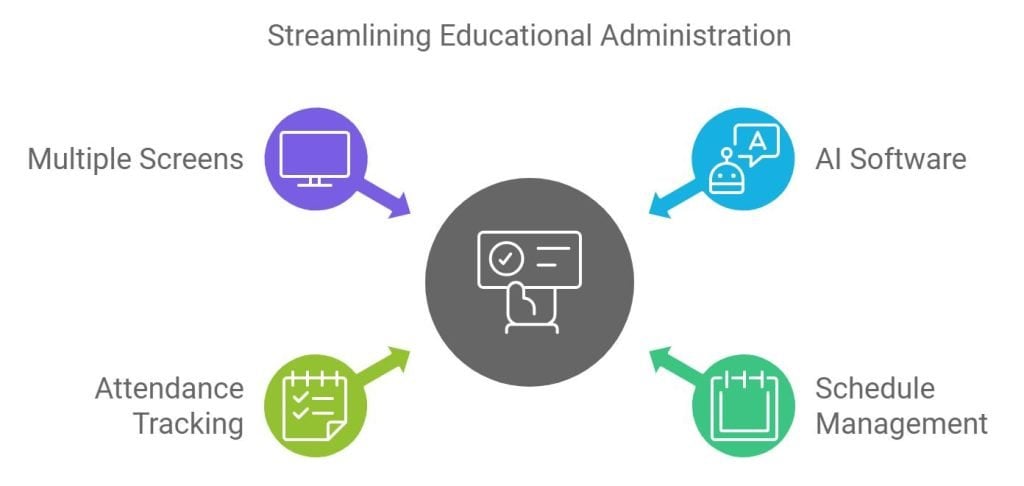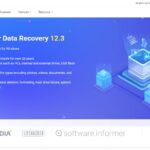Imagine a classroom where every student receives personalized attention, assignments adapt to their learning pace, and teachers are liberated from tedious administrative tasks.
This isn’t a scene from a futuristic novel—it’s the transformative power of Artificial Intelligence (AI) revolutionizing education today.
From smart tutoring systems to data-driven insights, AI is unlocking new horizons, making education more engaging, efficient, and tailored to individual needs.
The Impact of AI in Education
Why AI is Shaking Up Education
Artificial Intelligence (AI) is flipping the script in education by introducing fresh tools that make learning and teaching better. Forget the old-school one-way teaching. AI adds a personal touch that makes a student’s learning journey smoother. With smart algorithms doing their thing, AI adjusts what kids learn based on what they need. It’s in action big time with things like flexible learning systems and online tutoring.
AI tools can digest heaps of data and pinpoint trends that were probably missed before. Teachers can get a deeper look into how students tick and how they’re doing at school. This means they come up with smarter ways to help kids with their specific struggles. Want to see the nuts and bolts of what makes these systems tick? Check our piece on machine learning basics.
Benefits of AI Applications in Education
AI brings in a bag of goodies for education with its wide-ranging perks:
- Personalized Learning: AI creates a custom fit for learning, adjusting to how fast kids learn and the way they absorb stuff. This means lessons are more interesting and stick better.
- Automating the Boring Stuff: AI cuts out the tedious admin work like grading or setting up classes, giving teachers more time to actually teach. Curious how this vibe translates to business? Check out our article on AI tools for business.
- Better Student Help: Smart tutors and AI chats can offer quick help when students are stuck. They guide them like a GPS through tricky subjects. Explore similar tricks in customer service with our article on AI chatbots for customer service.
- Dig into Data: AI spills the beans on useful data insights that can shape how lessons are planned and taught. Teachers can then tailor their approach, upping the chances of students doing well. Dive into how big data and AI shake hands in our article on big data and AI.
- Predict and Prevent Problems: AI can spot when a student might slip up and step in before it happens, cutting down dropouts and boosting success rates.
| Benefit | Description |
|---|---|
| Personalized Learning | Tailors educational content to individual learning styles and paces. |
| Automating Stuff | Gets rid of the boring admin tasks so teachers can focus on the students. |
| Better Help | Provides quick help and guidance with virtual tutors and smart chats. |
| Dig into Data | Use insights to polish course content and teaching methods. |
| Predict Problems | Spots struggling students and steps in early, cutting down dropout numbers. |
AI is not just about making learning cooler but also about turbocharging the education system itself. It’s removing hurdles and opening doors wide open for students and teachers alike.
For more juicy details on the rights and wrongs of AI in different fields, check our chat on AI ethics. If you’re curious about how AI is shaking things up in other areas, take a peek at our insights on AI in healthcare and AI applications in finance.
Personalized Learning
AI, or what’s often dubbed as a “futuristic teacher assistant,” is jazzing up education by giving learning a facelift. It’s shaking off the dusty classroom vibes, making lessons click with students like never before. The magic happens most in Adaptive Learning Systems and those snazzy Individualized Feedback Mechanisms.
Adaptive Learning Systems
Adaptive learning systems use smart tech to make learning a personal journey, unique like snowflakes! Instead of a one-size-fits-all approach, these systems spot how a kid ticks, tackling assignments like a detective on a case. They’re the Sherlock Holmes of education, tweaking lessons to match each student’s pace, strengths, and those “uh-oh” moments.

Stumbling with math equations? These systems throw a lifebuoy with practice questions and handy tools. By singing the right tune at the right time, they keep students grooving and growing.
| Feature | Benefits |
|---|---|
| Real-Time Adjustments | Quick changes in content to match a student’s groove |
| Data-Driven Sleuthing | Spots what you’re ace at and what needs more elbow grease |
| Customized Game Plan | Personalized courses fitting each student’s rhythm |
| Classrooms that Stretch | Adapt to heaps of students with all kinds of learning quirks |
Curious about how these tech wizards work? Peek into our guide on machine learning basics for the inside scoop.
“Education is not the filling of a pail, but the lighting of a fire.”
— William Butler Yeats
Individualized Feedback Mechanisms
Forget waiting eons for feedback! With AI-powered feedback systems, students get the skinny on their work pronto. These systems don’t just say “good job” or “try harder”; they break it down, dishing out tips and tricks to snag that A.
Whether you’re doodling masterpieces or solving science mysteries, these mechanisms give tailor-made feedback. They consider how much you’ve nailed so far and what still feels like unkicking a stubborn jigsaw piece into place.
| Aspect | Description |
|---|---|
| Instant Grading | Flash-like evaluation of homework, tests, and quizzes |
| Customized Advice | Pointers on how to beef up skills using solved complaints and areas of confusion |
| Peer Power | See how you stack up against classmates and lesson goals |
| Long-Haul Tracking | Keeps tabs on growth, spotlighting how far you’ve trekked along |
Want the bigger picture on how AI is the hero in finance and healthcare too? Dive into AI applications in finance and AI in healthcare.
Rolling out adaptive learning systems and spiffy feedback tools sprinkles magic dust on education, notching up the learning spree and equipping teachers to tailor education better. Getting cozy with these innovations is key for anyone diving into AI education tricks, helping make our future schools a bit more like Hogwarts and a whole lot smarter.
“Technology is best when it brings people together.”
— Matt Mullenweg
Improving Administrative Tasks
Artificial Intelligence is changing how educational administration functions. Schools and universities using AI can manage everyday tasks more easily and focus on helping students thrive.

Streamlining Administrative Processes
AI is like having an extra pair of hands for educational staff—doing the boring bits faster and better. Whether it’s setting up the timetable, keeping tabs on who’s turning up, or figuring out resource needs, AI’s got it. Less grunt work, more time for real work.
The magic here is cutting the “oops” factor. You know, those little human mistakes. AI keeps a keen eye on all the details, so data is always spot-on and at your fingertips. Plus, it doesn’t just sit there; it thinks ahead, pointing out trends and insights to help make smarter choices.
| Administrative Task | Traditional Method Time (hrs/week) | AI-Enhanced Method Time (hrs/week) | Efficiency Gain (%) |
|---|---|---|---|
| Scheduling | 10 | 2 | 80 |
| Attendance Tracking | 5 | 1 | 80 |
| Resource Allocation | 8 | 3 | 62.5 |
Turning these tasks over to AI lets staff zero in on what matters most—like teaching and connecting with students. This shift boosts the overall learning vibe, making it livelier and more nurturing.
Enhancing Student Management Systems
AI isn’t just a helper for admin tasks; it’s changing how we manage students, too. These smart systems take care of things like signing up new students, keeping an eye on their grades, and looking after their well-being.
AI shakes up student management by providing tailored insights into how every student is doing, flagging those who might need a little extra help. It’s like a custom-fit learning experience, making sure no one falls through the cracks.
| Function | Traditional Method | AI-Enhanced Method |
|---|---|---|
| Enrollment | Manual Data Entry | Automated Form Processing |
| Academic Monitoring | Regular Assessments | Continuous Performance Analytics |
| Support Identification | Teacher Observations | Predictive Analysis |
By using AI, educators can spot patterns and adjust what they’re teaching. It makes the whole education experience smoother and more proactive.
For more on how AI is mixing things up in other fields, check out our pieces on AI applications in finance and AI in healthcare.
Bringing AI into educational management frees up time, cuts costs, and hones in on the individual needs of each student. With AI getting smarter by the day, the ways it can help in education are only growing.
If you’re curious about how AI works behind the scenes, check out our insights on machine learning basics and deep learning vs machine learning.
AI-Powered Tutoring and Support
Artificial Intelligence isn’t just for science fiction anymore—it’s reshaping education as we know it. Let’s dig into how AI is transforming tutoring and student help, making learning as smooth as butter.

Virtual Tutors and Assistants
Turns out, virtual tutors and AI assistants are like your favorite teacher on steroids. These clever systems mix machine-learning smarts with natural language magic to serve up tailored tutoring sessions. Imagine getting instant tips and tricks that fit your learning style like a glove.
Top Things About Virtual Sidekicks:
- Need help at 3 AM? No problemo. They’re always on.
- They whip up study schedules that fit you like a pair of old sneakers.
- You can have a back-and-forth with them like they’re a person who’s got your back.
- Chatbots that get you, just like those customer service bots but cooler.
| Feature | Why It Rocks |
|---|---|
| 24/7 Access | Midnight math problems? Sorted. |
| Tailor-Made Plans | Uses your study habits to make the best plan. |
| Real-Time Talk | Keeps chat lively and your brain tuned. |
| AI Chatbots | Quick fixes for any question on your mind. |
Student Support and Guidance Services
AI isn’t just a brainiac’s tool—it’s an all-rounder, covering student support better than a safety net. These smart systems use cracking analytics to keep tabs on students’ progress and get any strugglers back on track pronto.
Why AI Student Support Kicks Butt:
- Spotting who needs help before it’s too late.
- Personalized advice that’s as unique as your fingerprints.
- Keeps the lines open between students and teachers, big time.
- Zips through busywork so teachers can do what they do best—teach!
What do you think about AI? Don’t miss our scoop on AI in healthcare and AI finance wizardry.
| Benefit | Awesome Effect |
|---|---|
| Spotting Those Falling Behind | Helps before grades dive. |
| Personalized Pep Talks | Advice even your mom would approve. |
| Better Student-Teacher Chats | More convo, less awkward silence. |
| Skips Mundane Tasks | Teachers get to focus on the cool stuff. |
Bringing AI tutoring magic into schools isn’t just a tech upgrade—it’s about sending students soaring. Whether you’re into AI for managing businesses or leveling up in video games, we’ve got the 411, too. Check out AI tools for business and AI in gaming fun.
Enhancing Curriculum Development
Artificial Intelligence (AI) has shaken up the learning scene, changing how curriculum is made and handed out. It’s like AI opens the door to fresh possibilities using smarts and tech power to offer new ways to build and change educational content.
Data-Driven Insights for Curriculum Design
AI munches through mountains of data to spit out golden nuggets of wisdom for shaping lessons. It takes a careful look at how students are doing, how glued they are to their screens, and spots the study habits that need a tune-up or overhaul. This smarty-pants approach lines up lessons with what students actually need to learn, and aligns with their school goals since we all know the only way forward is through.
AI tools sift through info from tests, feedback forms, and all those online learning spots. By doing this, teachers get a clear picture of what’s working and what’s not—like whether students are eyeballing concepts sideways or they’re getting it right on point. Seeing these patterns allows teachers to tweak lessons and keep those knowledge gaps from getting too big.
| Data Source | Insight Type | Application |
|---|---|---|
| Student Assessments | Performance Trends | Identify underperforming areas |
| Feedback Forms | Student Engagement | Adjust teaching methods |
| Online Platforms | Learning Patterns | Customize content delivery |
Dynamic Content Creation and Customization
AI takes lesson planning to a whole new level by whipping up content that shifts gears depending on the student’s pace and understanding. Imagine it like a teacher adjusting the speed on a treadmill, ensuring each learner gets exactly what they need at the right moment.
Take personalized reading content, for example. AI can whip up different versions of reading materials that suit each kid’s level. It can also design quizzes that get tougher or easier as the student’s skills change. It’s like pulling from a magic hat of videos and animations to jazz up those textbooks, ramping up the engagement factor.
| Content Type | Customization | Benefit |
|---|---|---|
| Reading Materials | Adjust Reading Level | Personalized learning pace |
| Interactive Quizzes | Adaptive Difficulty | Targeted skill reinforcement |
| Multimedia Resources | Curated Videos/Animations | Enhanced engagement |
Adding AI flavor to curriculum design makes for a smoother, more engaging ride in the classroom. With its talent in smart data sense and creative content flair, teachers can make lessons that hit the mark for students of all kinds. For a deeper dive into AI uses, check out our piece on big data and AI.
Explore our articles on related topics:
- machine learning basics
- ai tools for business
- ai chatbots for customer service
- ai ethics
Assessments and Grading
Artificial Intelligence is shaking things up in education, especially when it comes to tests and marks. This bit shows off some cool AI tricks making life easier for teachers and students.
Automated Grading Systems
AI-powered grading systems are changing the game for teachers. They can knock out scores for essays, multiple-choice exams, and even coding projects, doing it faster and with surprising accuracy. As these systems keep learning from past data, they get even better at what they do, which makes them pretty dependable too.
| Assessment Type | Traditional Grading Time (hours) | Automated Grading Time (hours) |
|---|---|---|
| Essays | 10 | 2 |
| Multiple-Choice Tests | 5 | 0.5 |
| Coding Assignments | 8 | 1 |
The table above lays it out plain and simple: AI slashes hours spent on grading, meaning teachers can spend more time teaching and chatting with their students. Want to know how these smart algorithms tick? Check out Machine learning basics.
Analytics for Student Performance Tracking
AI tools are now helping track how students are doing, breaking down who’s rocking it and who might need a bit more help. By crunching big numbers, teachers can get a clear picture of how each student learns best. These tools pull data from test results, class participation, and homework efforts, painting a rich picture of student progress.
| Student Metric | Data Source | Analytical Insight |
|---|---|---|
| Test Scores | Exams and Quizzes | Pinpoint strengths and struggles |
| Participation | Classroom and Online Activities | Gauge engagement |
| Assignment Submissions | Homework and Projects | Keep tabs on discipline |
Armed with this info, teachers can craft personalized plans to help each student shine. Curious about AI’s role in schools? The big data and AI link has a ton of resources.
AI is flipping the script on how we handle grades and assessments, offering quicker, smarter ways to evaluate students. As AI tech grows, expect even cooler stuff to make learning better for everyone. If you’re interested in AI’s reach beyond classrooms, check out AI applications in finance and AI in healthcare.
Addressing Learning Challenges
Artificial Intelligence (AI) is shaking things up in education, tackling those tough learning hurdles. Two standout areas where AI makes a splash are crafting personal learning paths and spotting students who might need a little extra help.
Customized Learning Paths
AI-driven tools roll out the red carpet for students, giving them a learning experience that’s all about them. By crunching numbers from student performance, AI can gauge what students are good at and what trips them up, paving the way for personal learning paths. These platforms tweak course content on the fly, encouraging students to stay with it and feel the love during their education.
| Feature | What It Does |
|---|---|
| Data Analysis | Keeps an eye on and sizes up student performance. |
| Content Tweakage | Fine-tunes course stuff to fit student skill levels. |
| Speedy Feedback | Dishes out tips and extra goodies in a jiffy. |
Such smart systems don’t just give students a leg up by syncing with their go-to ways of learning; they also help teachers zero in on where students could use a hand. For a closer look at what makes adaptive learning tick, hop over to the bit about Adaptive Learning Systems.
Identifying and Supporting At-Risk Students
AI steps up when it comes to spotting students who might be hitting a rock and could use more backup. By taking a closer look at how students behave, show up, and their current grades, AI can single out those who seem to be having a hard time.
| Indicator | Signs |
|---|---|
| Academic Mojo | Not-so-great grades and unfinished assignments. |
| Behavior | Skipping class a lot and going radio silent. |
| Engagement | I’m not mingling much with any of the learning stuff. |
When AI picks out students waving a red flag, it helps roll out plans to get them back on track. This might mean personalized tutoring, special notes, or linking them up with a counselor who’s got their back. Dig into the scoop on AI-powered help in the section on Student Support and Guidance Services.
AI is changing the game in education by smoothing out tricky spots through custom learning routes and stepping in where students might wobble. For more about how AI is flipping things on its ear, check out our reads on machine learning basics and deep learning vs machine learning.
Ethical and Policy Considerations
In the whirlwind of educational tech, artificial intelligence (AI) tosses in both grand perks and some tricky ethical and policy hurdles. Finding footing with these hurdles is vital for keeping AI on the right track in schools.
Data Privacy in Education
A biggie in the AI-school mashup is keeping data private. AI systems chow down on loads of data and think about personal info, grades, and student behaviors. This data grabber raises a bunch of questions about how student info is handled.
Schools need to stick to tough privacy rules to shield students’ stuff. This means setting up tight security and making sure AI plays by the privacy rulebook.
| Key Considerations | Description |
|---|---|
| Data Collection | Clarify what’s grabbed and why. |
| Data Storage | Lockdown data to keep it from prying eyes. |
| Data Sharing | Tight reins on who gets to see what. |
| Informed Consent | Get the green light from students and parents. |
| Anonymization | Make data nameless where possible. |
For a real dive into the tech-ethics mix, check out our piece on AI ethics.
Ensuring Fairness and Transparency in AI Use
Making sure AI is fair and open in schools is another must-have. AI can unknowingly mirror biases from its training, leading to unequal treatment of student groups. This is especially worrisome in automated grading and adaptive learning systems.
Beating bias needs serious checks and balances on AI setups. Being crystal clear about how AI makes choices is key, too. Teachers need the inside scoop on how these silicon brains do their thing.
| Key Actions | Description |
|---|---|
| Bias Mitigation | Give those algorithms a fair audit. |
| Algorithm Transparency | Lay out how these digital brains tick. |
| Stakeholder Involvement | Loop educators and learners into AI rules. |
| Regular Reviews | Keep tabs on AI results and effects. |
Making sense of these elements aids in crafting a fair, open, and principled space for AI in schools. For a bigger view of AI and ethics, check out our thorough write-ups on big data and AI and AI in healthcare.
By squaring up to these ethical and policy puzzles, schools can flip AI into an ally for enriching learning spaces, all while respecting student rights and keeping school values intact.
Conclusion
Artificial Intelligence is not just enhancing education; it’s fundamentally transforming it. By personalizing learning experiences, automating administrative tasks, providing robust student support, and enabling data-driven curriculum development, AI is paving the way for a smarter, more inclusive educational landscape.
As we navigate the ethical and policy considerations, the integration of AI promises to empower both students and educators, ensuring a brighter and more efficient future for education.
Embracing these innovations today will unlock endless possibilities for tomorrow’s learners and teachers alike.
Additional Resources & Authority References
- Harvard Graduate School of Education – AI and Learning
https://www.gse.harvard.edu/ideas/tags/artificial-intelligence - OECD Report on AI and Education
https://www.oecd.org/education/artificial-intelligence-education-report
Frequently Asked Questions (FAQs)
How is AI personalizing learning for students?
AI analyzes individual student data to tailor lessons, pace, and content to fit each learner’s unique needs, enhancing engagement and retention.
What administrative tasks can AI automate in education?
AI can handle grading, scheduling, attendance tracking, and resource allocation, freeing up teachers to focus more on instruction and student interaction.
How do AI-powered tutors support students?
Virtual tutors and AI assistants provide instant help, personalized feedback, and adaptive learning paths, ensuring students receive support whenever they need it.
What are the ethical considerations of using AI in education?
Key concerns include data privacy, ensuring fairness and transparency in AI algorithms, and preventing biases that could affect student outcomes.
Can AI help identify at-risk students?
Yes, AI analyzes behavioral and academic data to flag students who may need additional support, allowing for timely interventions to improve their academic performance.




















